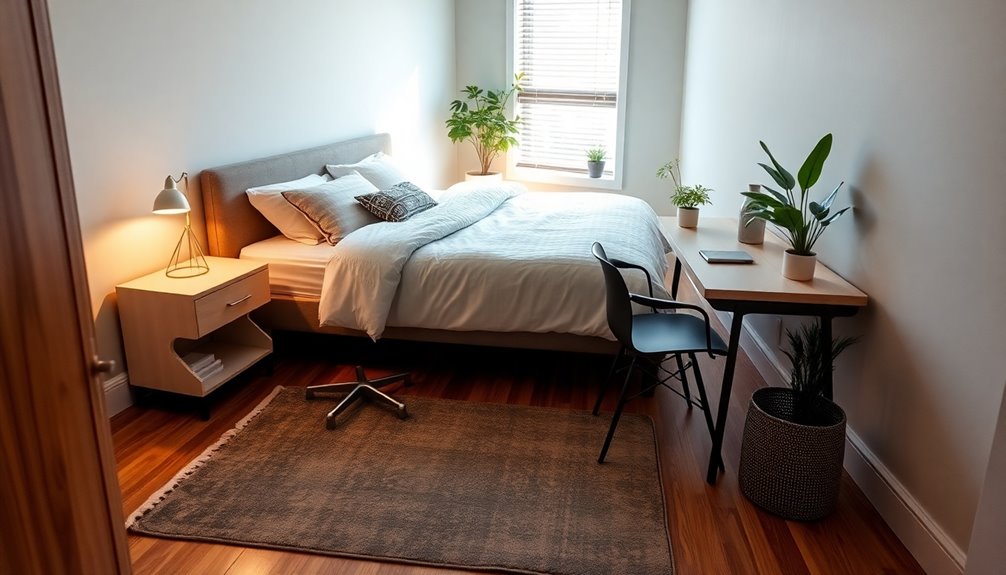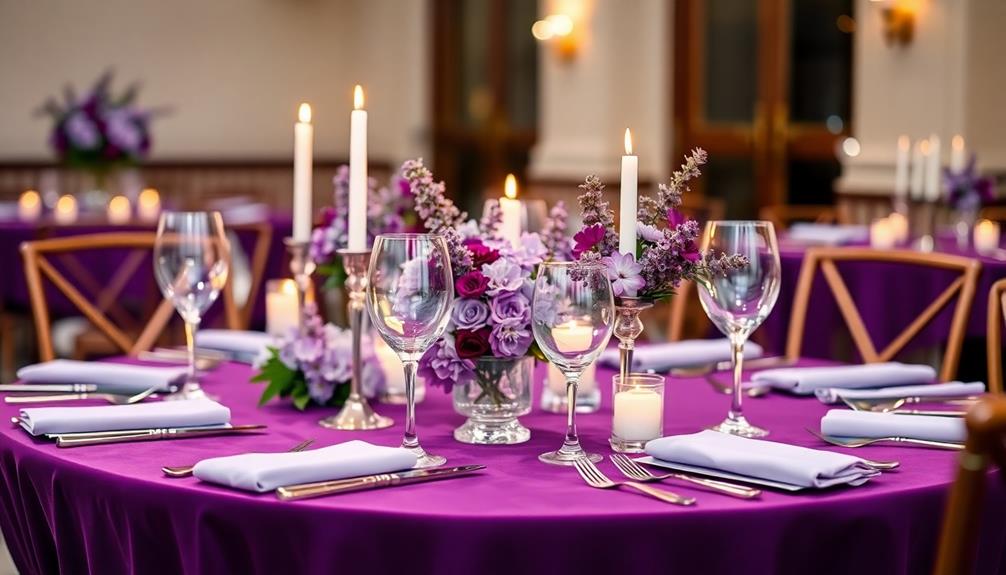To arrange furniture in a small bedroom, start by selecting medium-sized or multi-functional pieces to save space. Place your bed against the largest wall or in a cozy corner to maximize room flow. Utilize vertical space with shelves, and consider storage options like under-bed bins or ottoman beds to keep clutter at bay. Aim to leave walkways clear for easy movement, and avoid blocking windows for natural light. Layer your lighting with wall sconces and other fixtures to enhance the room’s ambiance. There’s plenty more to explore to make your small bedroom feel spacious and inviting. Additionally, when arranging furniture in long living rooms, consider creating distinct areas for different activities, such as a reading nook or a conversation zone. Use rugs to define these spaces and draw attention to key furniture pieces, like sofas and coffee tables. By thoughtfully organizing your layout, you can achieve a harmonious balance in both small bedrooms and elongated living environments.
Key Takeaways
- Position the bed against the largest wall to maximize space and create a focal point in the room.
- Utilize vertical space with wall-mounted shelves and consider multi-functional furniture to save floor space.
- Ensure clear pathways for movement by avoiding overcrowding and blocking windows with furniture.
- Incorporate lighting solutions like wall sconces and pendant lights to enhance functionality without taking up floor space.
- Sketch a floor plan or use online tools to visualize the layout before arranging furniture for optimal usage.
Furniture Selection Tips
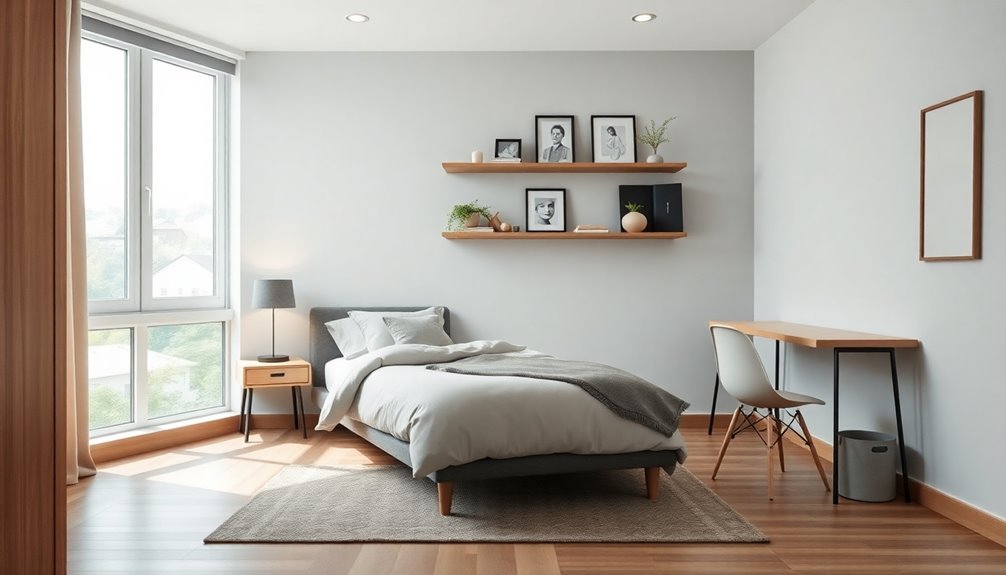
When arranging furniture in a small bedroom, it's crucial to select pieces that fit the scale of your space. Avoid oversized accent chairs, massive dressers, or sleigh beds that can overwhelm the room. Instead, opt for a medium-sized bed, ensuring you have space on both sides for bedside tables. Choose taller, narrower furniture to maximize your vertical space and create the illusion of height. Incorporating Montessori toys can further enhance the room's functionality by providing educational play options for children.
Minimal and streamlined design is key. Look for unfussy furniture with matte finishes and simple lines that keep your room feeling open and uncluttered. Airy pieces, such as those with tall, narrow legs, can help maintain that minimalist vibe. Avoid bulky or redundant items to enhance the overall aesthetic. Incorporating multi-functional furniture allows for creative solutions that save space and boost utility.
Multi-functional furniture is a game changer in small bedrooms. Select a stool that doubles as a side table or a plant stand, and consider a nightstand that combines desk space with storage. Storage ottomans can offer both seating and a smart storage solution. Install built-in shelving above your bed for additional storage without sacrificing floor space. By choosing the right furniture, you can create a functional and stylish small bedroom.
Optimal Bed Placement
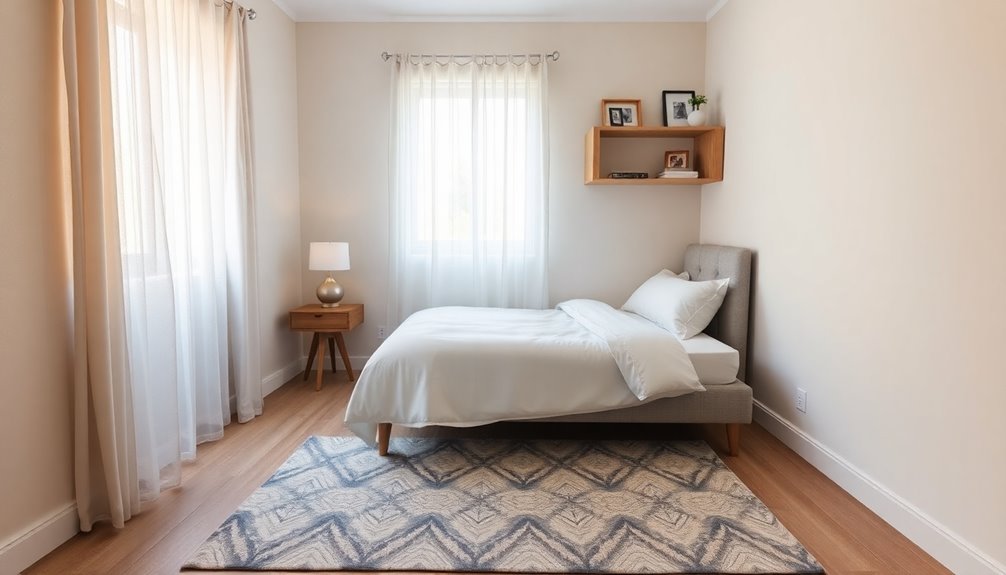
Choosing the optimal bed placement in a small bedroom can significantly enhance both functionality and aesthetics. One effective option is to place the bed against the largest wall. This arrangement not only maximizes space but also creates a sense of continuity, making the room feel more elongated. If you have a futon or daybed, this setup works especially well in studio apartments.
Another option is to position the bed in a corner, which can brighten up dark areas and give the illusion of a larger space. A tall headboard can draw the eye towards the farthest end of the room, enhancing the overall perception of space. Additionally, utilizing corner placement can create a cozy and intimate sleeping area, perfect for maximizing every inch of your small bedroom.
If you prefer a more elegant touch, consider placing the bed under a window. This setup allows natural light to brighten the room while freeing up wall space for additional decor.
Finally, facing the door is another smart choice. This placement offers security and comfort while maintaining symmetry, ensuring an unobstructed pathway when the door opens. Each of these placements can transform your small bedroom into a more functional and inviting space.
Creative Storage Solutions
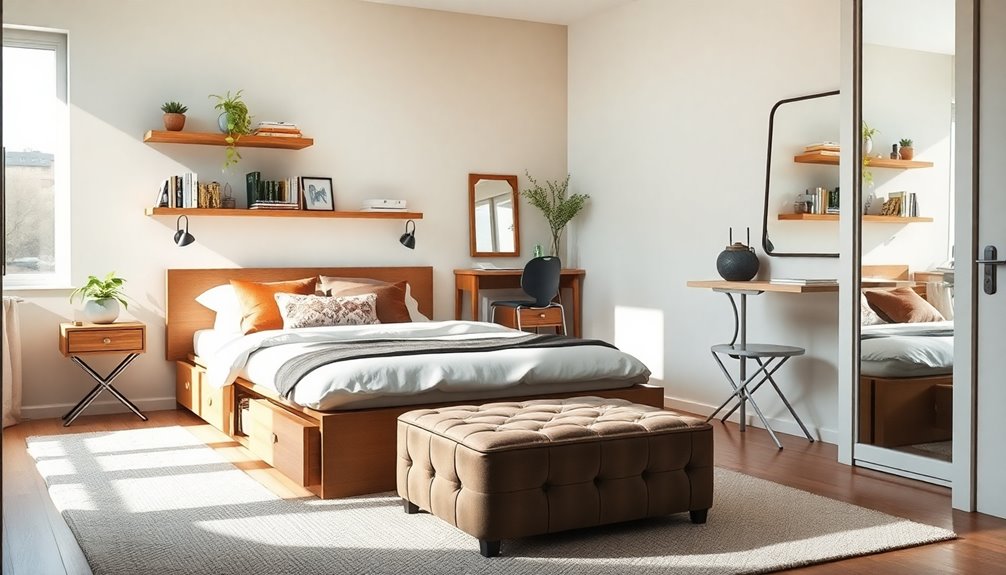
Maximizing storage in a small bedroom can be a game changer for maintaining order and style. Start by utilizing vertical space—install wall-mounted shelves to keep the floor clear and add storage without crowding the room. Consider tall dressers and overhead cabinets that provide ample space without encroaching on your living area. Floating shelves not only add modern flair but also serve as functional storage. Additionally, you can incorporate wall-mounted baskets to further enhance your storage options while adding a decorative touch. Incorporating open shelving can also add both storage and a rustic charm to your bedroom decor.
Invest in multi-functional furniture like beds with storage drawers or ottoman beds that hide compartments beneath the mattress. Storage benches can double as seating while providing extra space for blankets. Fold-down desks transform a small area into a functional workspace when needed.
Don't overlook hidden storage solutions. Use clear bins under your bed for easy access or a stealth storage bench at the foot of your bed. Built-in shelving around the bed offers a tidy way to keep clutter out of sight. Finally, embrace wall-mounted and hanging solutions, like laundry hampers or bedside caddies, to save floor space while keeping essentials within reach. With these creative storage ideas, you'll make the most of your small bedroom, combining style and functionality seamlessly.
Lighting Considerations

Creative storage solutions can significantly enhance the functionality of a small bedroom, but lighting considerations are just as important for creating a welcoming and spacious feel. Start by selecting floor-space-saving fixtures like pendants or flush mount lights that lay flat against the ceiling. This choice minimizes clutter while ensuring the room remains well-lit. Wall-mounted sconces can serve as a primary light source or complement other fixtures, enhancing both utility and design. Additionally, consider using pendants for bedside lighting to free up valuable nightstand space.
Layering lighting is key; mix ambient, decorative, and task lighting to create depth. Use table lamps, LED light strips, and string lights for a cozy atmosphere. Position each light source strategically to serve specific purposes, like task lighting near your bed.
Maximize natural light by optimizing window placement and using sheer curtains that allow light to filter through while preserving privacy. Mirrors can also reflect natural light, making your room feel airier.
Finally, choose fixtures that are proportional to your space. Opt for decorative elements that enhance aesthetics without overwhelming the room. By thoughtfully considering your lighting, you'll create a bright, inviting atmosphere that complements your small bedroom's design.
Effective Layout Planning
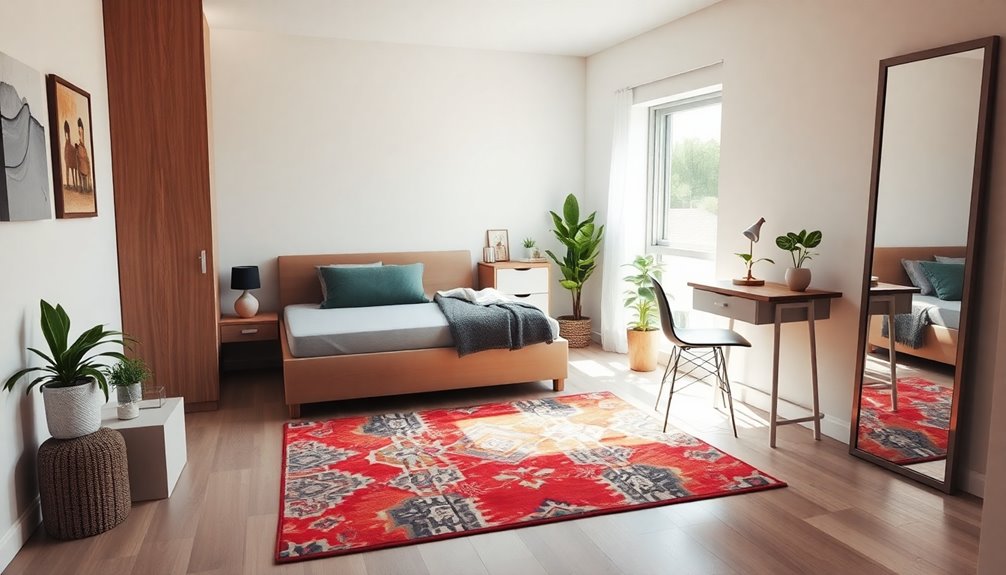
When it comes to arranging furniture in a small bedroom, getting the layout right can make all the difference. Start by positioning your bed in the center of the most visible wall to achieve symmetry while maximizing space. Avoid blocking windows to maintain natural light and ensure accessibility. If your room is narrow, consider fitting the bed snugly into a corner to free up floor space.
Next, think about storage and furniture that serves multiple purposes. Use built-in cabinetry for personalized storage, and consider storage beds or under-bed options for out-of-season clothes. Chests of drawers can double as bedside tables, helping reduce clutter. You might also incorporate a storage ottoman at the foot of the bed. Vertical storage solutions can also help utilize wall space effectively, drawing the eye upward and creating a sense of height.
For furniture selection, avoid crowding the room by leaving clear spaces for movement. A desk can serve as a nightstand, combining functions effectively. Use area rugs to create a cohesive look and consider built-in window seats for extra seating. Finally, sketch a floor plan or use online tools to visualize your layout, ensuring you make the most of every awkward space while maintaining a serene flow.
Frequently Asked Questions
How Can I Choose a Color Scheme for a Small Bedroom?
Choosing a color scheme for your small bedroom can transform the space. Start by opting for light and neutral tones, as they'll make the room feel larger and more inviting. Incorporate soft blues or earthy shades for a calming effect. Assess the natural light to select colors that reflect it well. Consider using monochromatic schemes or subtle accent colors to create depth without overwhelming the space. Remember, balance is key for a harmonious look!
What Types of Textiles Work Best in a Compact Space?
When you're choosing textiles for a compact space, go for small-scale fabric patterns. They bring subtlety and depth without overwhelming your room. Look for versatile applications like decorative pillows and lampshades that enhance your decor. Opt for refined designs featuring delicate motifs, like florals or geometrics, to create a sophisticated look. Pair these textiles with larger patterns or solid colors for a cohesive feel, ensuring your space feels inviting and stylish.
How Do I Incorporate Personal Decor Without Cluttering?
To incorporate personal decor without cluttering, focus on a few meaningful pieces that resonate with you. Choose items that serve dual purposes, like decorative storage boxes. Use slim, vertical decor to draw the eye upwards and create depth. Balance out bold patterns with neutral tones to keep it calm. Finally, don't forget about lighting; it can enhance the ambiance while taking up minimal space. Remember, less is often more when it comes to personal touches.
What Are the Best Flooring Options for Small Bedrooms?
When choosing flooring for a small bedroom, consider options like vinyl for its affordability and versatility. Laminate offers durability and easy installation, mimicking wood or stone. If you prefer a natural look, light-colored hardwood can brighten your space. Cork is eco-friendly and provides comfort, while bamboo gives a warm aesthetic. Each option has its benefits, so think about what fits your style and maintenance preferences best.
How Can I Create a Cozy Atmosphere in a Small Room?
To create a cozy atmosphere in your small room, start by mixing textures with plush rugs, cushions, and soft blankets. Use natural materials like wood accents and jute rugs for warmth. Incorporate soft lighting with lamps or string lights, and avoid harsh ceiling lights. Add greenery and decorative items to personalize the space. Finally, choose warm paint colors and high-quality linens to enhance that inviting, snug feel you're aiming for.
Conclusion
By thoughtfully selecting furniture and placing your bed optimally, you can transform your small bedroom into a cozy retreat. Don't forget to incorporate creative storage solutions and consider your lighting to enhance the space further. With a bit of planning, you can create an effective layout that maximizes both comfort and functionality. Embrace these tips, and you'll find that even a small bedroom can feel spacious and inviting. Happy decorating!
